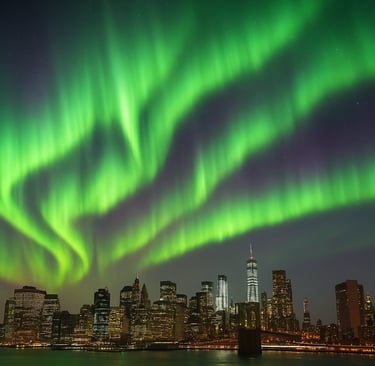Northern Lights Over New York? 😱 Tonight’s Rare Solar Show! | Rare Aurora Event
Rare Aurora Event may be visible as far south as New York City tonight due to strong solar activity. 🌌💫 Experts say this rare aurora sighting could illuminate skies across the Northeast. Check the visibility map and step outside tonight — you might just see nature’s most stunning light show!
Mr Umar Bilal
11/13/20254 min read


🌌 A Rare Night for NYC Skywatchers
New York City might witness a rare natural wonder tonight — the Aurora Borealis, also known as the northern lights.
According to NOAA’s Space Weather Prediction Center, a strong G3–G4 geomagnetic storm is expected to make the northern lights visible farther south than usual. That means residents in parts of New York, New Jersey, and Connecticut may see a colorful glow in the night sky.
It’s not every day that the Big Apple gets a shot at seeing this polar phenomenon. Normally, auroras appear near the Arctic regions — places like Alaska, Iceland, or Norway. But tonight, the dancing lights of solar particles might just reach NYC’s horizon.
☀️ What’s Behind the Aurora Tonight
The beauty you might see in the sky starts nearly 93 million miles away — at the Sun.
Recently, a solar flare and coronal mass ejection (CME) were recorded by NASA and NOAA. These massive bursts of solar plasma travel toward Earth, and when they collide with our planet’s magnetic field, they create beautiful colors of light in the sky — red, purple, pink, and green.
This activity is part of the current solar cycle peak. The sun’s magnetic field flips roughly every 11 years, producing more flares and storms. These geomagnetic disturbances are responsible for expanding the auroral oval — the region where the northern lights are visible.
For New Yorkers, that means a rare opportunity to catch the spectacle without traveling to the Arctic Circle.
📍 Where You Can See the Northern Lights Near NYC
Light pollution is the biggest challenge when viewing the aurora from a city as bright as New York.
If you’re serious about catching a glimpse, here are some of the best nearby locations where dark skies give you a better chance:
🌄 1. The Catskill Mountains (NY)
A two-hour drive north from NYC, the Catskills offer dark, wide-open skies. Locations like Hunter Mountain or North–South Lake are ideal spots to see the faint glow on the northern horizon.
🌲 2. Hudson Valley (NY)
Towns like New Paltz, Rhinebeck, and Kingston offer open spaces and lower light pollution. Face north and you might spot shimmering lights above the tree line.
🌃 3. Bear Mountain State Park
Just an hour from the city, Bear Mountain provides elevated viewpoints and darker skies compared to Manhattan or Brooklyn.
🌌 4. Northwestern New Jersey (Highlands Region)
If you’re in New Jersey, travel toward Sussex County or High Point State Park. The elevated terrain helps reduce the horizon glow from city lights.
Even if you can’t leave NYC, head to Staten Island’s South Beach, Coney Island, or the Rockaways — open coastal spots where you can at least look north without skyscrapers blocking your view.
🕐 Best Time to Watch the Aurora
Timing is everything tonight.
The aurora is expected to peak between 10 p.m. and 2 a.m. EST, but activity can start as early as sunset.
Here’s how to plan your viewing:
🌒 Check the sky after dusk.
🌠 Monitor the Kp index — if it’s above 7, visibility improves.
🧭 Face north toward the darkest part of the horizon.
📷 Stay ready with your camera or phone.
If skies remain clear and the storm stays strong, you could witness shifting curtains of light dancing in slow waves. Even if you don’t see vibrant color with the naked eye, cameras often capture the green and pink hues first.
📸 How to Capture the Northern Lights on Camera
Auroras can be faint to the eye but stunning in photos. Follow these simple tips to photograph them like a pro:
Use a tripod — keeps your camera steady during long exposures.
Turn on night mode or manual exposure (10–15 seconds).
Set ISO between 800–1600 to capture light without too much noise.
Focus manually on infinity or distant lights.
Avoid flash — it washes out the natural colors.
Shoot in RAW format for better editing later.
Even smartphones can do a good job if you hold still or prop the device against a stable surface.
🌧️ Weather Conditions Matter
Your ability to see the aurora depends not just on the geomagnetic storm but also on cloud cover and air clarity.
Check the latest aurora forecast maps from NOAA or SpaceWeatherLive.com to see the “view line” — a curved boundary showing where the lights are likely visible.
You can also use apps like:
My Aurora Forecast & Alerts
SpaceWeatherLive
AuroraNow
These apps send alerts when the KP index spikes and show real-time data from magnetometers around the world.
If clouds stay away and visibility is clear, NYC-area skywatchers could experience a faint green or reddish hue across the northern skyline — a truly magical sight for urban stargazers.
🔬 Science Behind the Colors
Each aurora color tells a story about atoms colliding in Earth’s atmosphere:
💚 Green — oxygen molecules about 60 miles up.
❤️ Red — oxygen higher than 150 miles.
💜 Purple or pink — nitrogen molecules.
💛 Blue — hydrogen and helium interactions.
The altitude and energy of incoming solar particles determine which colors appear. That’s why each aurora is different — like fingerprints in the sky.
⚠️ What Could Prevent Visibility Tonight
Even though forecasts are strong, there’s no guarantee everyone in NYC will see the northern lights.
Factors that can ruin visibility include:
Cloud cover or fog.
Urban glow from skyscrapers and streetlights.
Low geomagnetic activity at your exact location.
Facing the wrong direction (always look north).
If the skies look dull, don’t be disappointed. The storm could last multiple days — meaning you might get another chance tomorrow night if conditions stay active.
💡 Safety & Viewing Etiquette Tips
When heading out to view or photograph the aurora:
Bring a flashlight with red light mode to preserve night vision.
Dress warmly — temperatures drop quickly at night.
Avoid shining lights or phone screens at others.
Respect private property if exploring rural areas.
Stay alert if parking along roadsides or in dark parks.
Enjoying the aurora safely and respectfully ensures everyone can have a good viewing experience.
🌠 Final Thoughts: NYC’s Rare Brush With the Aurora
For a city known for bright billboards and skyscrapers, seeing nature’s own light show is extraordinary.
The last time a geomagnetic storm of this strength touched the U.S. East Coast, residents reported auroras as far south as Virginia and even Texas.
Tonight’s event may not paint the Manhattan skyline green, but for anyone with a clear view and a little patience, the experience will be unforgettable.
If you catch it — even faintly — you’ll be part of a small group of New Yorkers who can say they saw the northern lights over New York City.
So grab your coat, step outside, and look up. The sky might just surprise you tonight. ✨
🔖
#NorthernLights #AuroraBorealis #NYC #SkyWatch #SpaceWeather #AuroraAlert #NightSky #Stargazing #SolarStorm #AuroraHunting #NYCEvents
